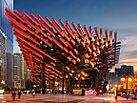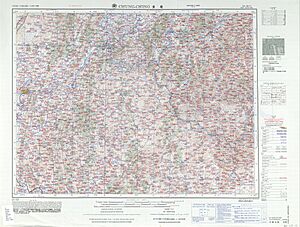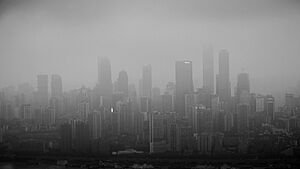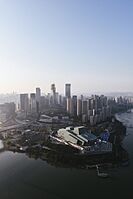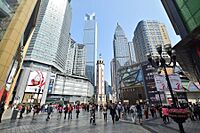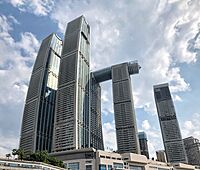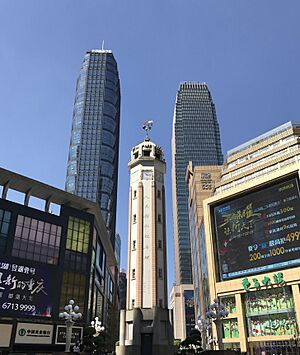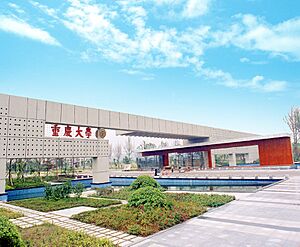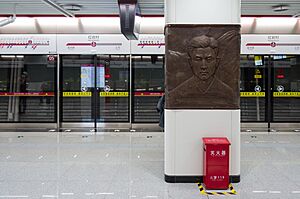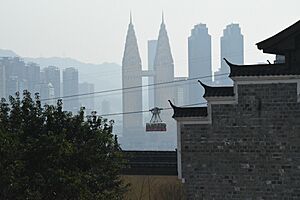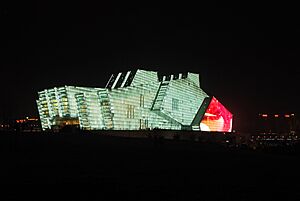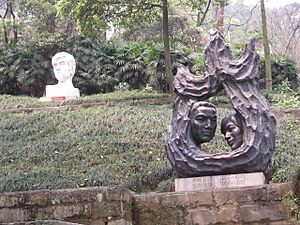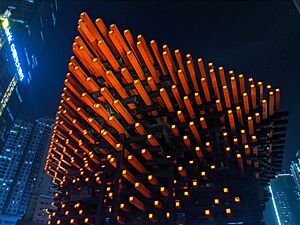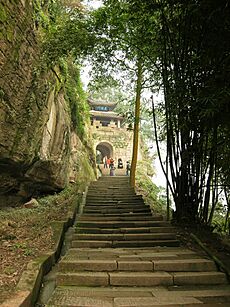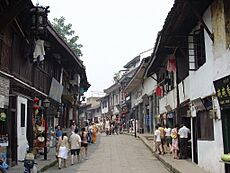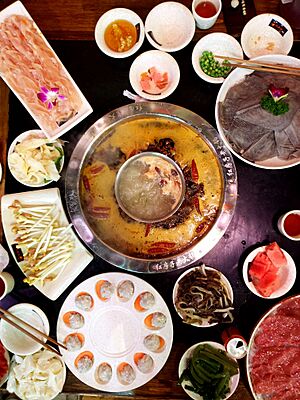Chongqing facts for kids
Quick facts for kids
Chongqing
重庆
Chungking
|
|||||||||||
|---|---|---|---|---|---|---|---|---|---|---|---|
|
Municipality
|
|||||||||||
|
Yuzhong District
Chongqing Art Museum
Liziba Station
Jiefangbei CBD
Qutang Gorge
Huguang Huiguan
Great Hall of the People
|
|||||||||||
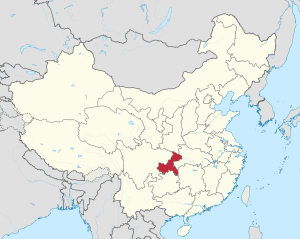
Location of Chongqing Municipality within China
|
|||||||||||
| Country | China | ||||||||||
| Settled | c. 316 BC | ||||||||||
| Separated from Sichuan | 14 March 1997 | ||||||||||
| Municipal seat | Yuzhong District | ||||||||||
| Divisions - County-level - Township-level |
26 districts, 12 counties | ||||||||||
| Government | |||||||||||
| • Type | Municipality | ||||||||||
| • Body | Chongqing Municipal People's Congress | ||||||||||
| Area | |||||||||||
| • Municipality | 82,403 km2 (31,816 sq mi) | ||||||||||
| • Built up area | 5,472.8 km2 (2,113.1 sq mi) | ||||||||||
| Elevation | 244 m (801 ft) | ||||||||||
| Highest elevation
(Yintiao Ling)
|
2,797 m (9,177 ft) | ||||||||||
| Population
(2020 census (total), 2018 (otherwise))
|
|||||||||||
| • Municipality | 32,054,159 | ||||||||||
| • Density | 388.9926/km2 (1,007.486/sq mi) | ||||||||||
| • Urban | 22,251,500 | ||||||||||
| • Built up area | 9,580,770 | ||||||||||
| • Built up area density | 1,750.616/km2 (4,534.07/sq mi) | ||||||||||
| GDP(2023) | |||||||||||
| • Municipality | CN¥ 3,015 billion (17th) US$ 428 billion |
||||||||||
| • Per capita | CN¥ 94,135 (10th) US$ 13,359 |
||||||||||
| Time zone | UTC+8 (CST) | ||||||||||
| • Summer (DST) | UTC+9 (CDT) | ||||||||||
| Postal codes |
4000 00 – 4099 00
|
||||||||||
| Area code(s) | 23 | ||||||||||
| ISO 3166 code | CN-CQ | ||||||||||
| – Growth | |||||||||||
| Abbreviation | CQ / 渝; Yú | ||||||||||
| Climate | Cfa | ||||||||||
| HDI (2022) | 0.795 (9th) – high | ||||||||||
|
|||||||||||
| Chongqing | |||||||||||||||||||||||||||||||||||||||||||
|---|---|---|---|---|---|---|---|---|---|---|---|---|---|---|---|---|---|---|---|---|---|---|---|---|---|---|---|---|---|---|---|---|---|---|---|---|---|---|---|---|---|---|---|

"Chongqing" in Simplified (top) and Traditional (bottom) Chinese characters
|
|||||||||||||||||||||||||||||||||||||||||||
| Simplified Chinese | 重庆 | ||||||||||||||||||||||||||||||||||||||||||
| Traditional Chinese | 重慶 | ||||||||||||||||||||||||||||||||||||||||||
| Postal | Chungking | ||||||||||||||||||||||||||||||||||||||||||
| Literal meaning | "Doubled Celebration" | ||||||||||||||||||||||||||||||||||||||||||
|
|||||||||||||||||||||||||||||||||||||||||||
Chongqing is a direct-administered municipality in Southwestern China. Chongqing is one of the four direct-administered municipalities under the Central People's Government, along with Beijing, Shanghai, and Tianjin. It is the only directly administrated municipality located deep inland. The municipality covers a large geographical area roughly the size of Austria, which includes several disjunct urban areas in addition to Chongqing proper. Due to its classification, the municipality of Chongqing is the largest city proper in the world by area, though it does not have the largest urban area.
The municipality of Chongqing is the only Chinese municipality with a resident population of over 30 million; however, this number includes its large rural population. In 2020, Chongqing surpassed Shanghai as China's largest municipality by urban population; as of 2022[update], it has an urban population of 22.8 million. The municipality contains 26 districts, 8 counties, and 4 autonomous counties. The city served as the wartime capital for the Republic of China (ROC) during the Second Sino-Japanese War (1937–1945). On 14 March 1997, the current municipality was separated from the surrounding province of Sichuan, with the goal of furthering development in the central and western parts of the country. University of Washington professor Kam Wing Chan argued that Chongqing's status is more akin to that of a province rather than a city.
As one of China's National Central Cities, Chongqing serves as a center for finance in the Sichuan Basin and the upstream Yangtze, as well as for manufacturing and transportation. It is a connection in the Yangtze River Economic Belt and a base for the country's Belt and Road Initiative. Chongqing Jiangbei International Airport is the second-busiest airport in China, and is one of the top 50 busiest airports in the world. The city's monorail system is the world's longest and busiest, as well as having the greatest number of stations, with 70. Chongqing is ranked as a Beta (global second-tier) city. It is the headquarters of the Changan Automobile, one of the "Big Four" car manufacturers of China. As of 2023[update], the city hosts 12 foreign representations, the fifth-most in China behind Beijing, Shanghai, Guangzhou, and Chengdu. It is one of the top 40 cities globally by scientific research output, as tracked by the Nature Index; the municipality is home to several notable universities, including Chongqing University, Southwest University, and Chongqing University of Posts and Telecommunications.
Contents
History
Antiquity
Chongqing's location is historically associated with the State of Ba. Its capital was first called Jiangzhou (江州).
Imperial era
Jiangzhou subsequently remained under Qin Shi Huang's rule during the Qin dynasty, the successor of the Qin State, as well as the rule of Han dynasty emperors. Jiangzhou was subsequently renamed during the Northern and Southern dynasties to Chu Prefecture (楚州), then again in 581 AD (Sui dynasty) to Yu Prefecture (渝州), and later in 1102 during Northern Song to Gong Prefecture (恭州). The name Yu however survives to this day as an abbreviation for Chongqing, as well as for the city's historic center, where the old town once stood; its name is Yuzhong (渝中, Central Yu). It received its current name in 1189, after Prince Zhao Dun of the Southern Song dynasty described his crowning as king and then Emperor Guangzong as a "double celebration" (simplified Chinese: 双重喜庆; traditional Chinese: 雙重喜慶; pinyin: shuāngchóng xǐqìng, or chóngqìng in short). To mark the occasion of his enthronement, Yu Prefecture was therefore converted to Chongqing Fu.
In 1362 (during the Yuan dynasty), Ming Yuzhen, a peasant rebel leader, established the Daxia Kingdom (大夏) at Chongqing for a short time. In 1621 (during the Ming dynasty), another short-lived kingdom of Daliang (大梁) was established by She Chongming (奢崇明) with Chongqing as its capital. In 1644, after the fall of the Ming dynasty to a rebel army, Chongqing, together with the rest of Sichuan, was captured by Zhang Xianzhong, who was said to have massacred a large number of people in Sichuan and depopulated the province, in part by causing many people to flee to safety elsewhere. The Manchus later conquered the province, and during the Qing dynasty, immigration to Chongqing and Sichuan took place with the support of the Qing emperor.
In 1890, the British Consulate General was opened in Chongqing. The following year, the city became the first inland commerce port open to foreigners, with the proviso that foreign ships should not be at liberty to trade there until Chinese-owned steamers had succeeded in ascending the river. This restriction was abolished by the Treaty of Shimonoseki in 1895, which declared the city open on the same terms as other ports, although it was not until 1907 that a steamship made the journey without the help of manual haulers. From 1896 to 1904, the American, German, French, and Japanese consulates were opened in Chongqing.
Provisional wartime capital of the Republic of China
During and after the Second Sino-Japanese War, from November 1937 to May 1946, it was Generalissimo Chiang Kai-shek's provisional capital. After the General and remaining army had lived there for a time following their retreat in 1938 from the previous capital of Wuhan, it was formally declared the second capital city (Chinese: 陪都; pinyin: péidū; Wade–Giles: p'ei2-tu1) on 6 September 1940. After Britain, the United States, and other Allies entered the war in Asia in December 1941, one of the Allies' deputy commanders of operations in Southeast Asia (Southeast Asia Command SEAC), Joseph Stilwell, was based in the city. This made it a city of world importance in the fight against Axis powers, together with London, Moscow and Washington, D.C.
The city was also visited by Lord Louis Mountbatten, the Supreme Commander of SEAC which was itself headquartered in Sri Lanka. Chiang Kai Shek as Supreme Commander in China worked closely with Stilwell. From 1938 to 1943, the city suffered from continuous massive bombing campaigns of the Imperial Japanese Navy and Army Air Forces; battles of which were fought entirely by the Chinese Air Force squadrons and anti-aircraft artillery units. Many lives were saved by the air-raid shelters which took advantage of the mountainous terrain. Chongqing was acclaimed to be the "City of Heroes" due to the indomitable spirits of its people as well as their contributions and sacrifices during the War of Resistance-World War II. Many factories and universities were relocated from eastern China and ultimately to Chongqing during years of setbacks in the war, transforming this city from inland port to a heavily industrialized city. In late November 1949, the Nationalist KMT government withdrew from the city by air.
Municipality status
On 14 March 1997, the Eighth National People's Congress decided to merge the sub-provincial city with adjacent Fuling, Wanxian, and Qianjiang prefectures that it had governed on behalf of the province since September 1996, and grant it independence from Sichuan. The resulting single entity became Chongqing Municipality, containing 30,020,000 people in forty-three former counties without intermediate political levels. The municipality became the spearhead of China's effort to develop its western regions and to coordinate the resettlement of residents from the reservoir areas of the Three Gorges Dam project. Its first official ceremony took place on 18 June 1997.
On 8 February 2010, Chongqing became one of the four National Central Cities, along with Beijing, Shanghai and Tianjin. According to Zhou Liqun, a consultant for National Development and Reform Commission of China, Chongqing's status as a National Central City would encourage the development of Western China. Chongqing, which is located in central-western China, would complement the other National Central Cities, all of which are located along China's eastern coastline. The same year on June 18, the Liangjiang New Area was established in Chongqing, which was the third state-level new area at the time of its establishment.
Geography
Physical geography and topography
Chongqing is located in the subtropics, situated in the transitional area between the Tibetan Plateau and the plain on the middle and lower reaches of the Yangtze. Its climate features frequent monsoon conditions, often raining at night in late spring and early summer. The city's "night rain in the Ba Mountains", features in poems throughout Chinese history, including "Written on a Rainy Night—A Letter to the North" by Li Shangyin. Its territory is 470 km (290 mi) from east to west at its longest, and 450 km (280 mi) from north to south at its widest. It borders Hubei and Hunan to the east, Sichuan and Shaanxi to the north, and Guizhou to the south.
Chongqing covers a large area crisscrossed by rivers and mountains. The Daba Mountains stand in the north, the Wu Gorge in the east, the Wuling Mountains in the southeast, and the Dalou Mountains in the south. The area slopes downward from north to south towards the Yangtze valley, and features a large massif of mountains and hills, with steep sloping areas at different heights. Karst landscape is common in this area, and stone forests, numerous collections of peaks, limestone caves and valleys can be found in many places. The Longshuixia Gap (龙水峡地缝), with its Three Natural Bridges, has made the region a popular tourist attraction. The Yangtze River runs through the whole area from west to east, covering a course of 665 km (413 mi), cutting through the Wu Mountains at three places and forming the well-known Three Gorges: the Qutang, Wuxia and Xiling gorges. Coming from northwest and running through "the Jialing Lesser Three Gorges" of Libi, Wentang and Guanyin, the Jialing River joins the Yangtze in Chongqing.
Leaving at dawn the White Emperor crowned with cloud,
I've sailed a thousand li through canyons in a day.
With the monkeys' adieus the riverbanks are loud,
My skiff has left ten thousand mountains far away.
The central urban area of Chongqing, called Chongqing proper, is built on mountains and partially surrounded by the Yangtze and Jialing rivers. With its special topography, Chongqing's topography includes mountains, rivers, forests, springs, waterfalls, gorges, and caves. The Tang dynasty poet Li Bai was inspired by the natural scenery and wrote this epigram.
The Zhongliang (中梁山) and Tongluo (铜锣山) mountains roughly form the eastern and western boundaries of Chongqing's urban area. Several high mountains are situated outside central Chongqing, including the 1,709.4 m (5,608 ft)-high Wugong Ling Mountain in Jiangjin.
Climate
Chongqing has a monsoonal humid subtropical climate (Köppen Cwa), bordering on a humid subtropical climate (Köppen Cfa) and for most of the year experiences very high relative humidity, with all months above 75%. Known as one of the "Three Furnaces" of the Yangtze River, along with Wuhan and Nanjing, its summers are long and among the hottest and most humid in China, with highs of 34 °C (93 °F) in July and August in the urban area. Winters are short and somewhat mild, but damp and overcast. The city's location in the Sichuan Basin causes it to have one of the lowest annual sunshine totals nationally, at only 983 hours, lower than much of Northern Europe; the monthly percent possible sunshine in the city proper ranges from a mere 5% in January to 43% in August. Extremes since 1951 have ranged from −1.8 °C (29 °F) on 15 December 1975 (unofficial record of −2.5 °C (27 °F) was set on 8 February 1943) to 43.7 °C (111 °F) on 18 and 19 August 2022 (unofficial record of 44.0 °C (111 °F) was set on 8 and 9 August 1933).
Chongqing, with over 100 days of fog per year, is known as the "Fog City" (雾都); this is because in the spring and fall, a thick layer of fog enshrouds it for 68 days per year. During the Second Sino-Japanese War (1937–1945), this special weather possibly played a role in protecting the city from being overrun by the Imperial Japanese Army.
| Climate data for Chongqing (Shapingba District), elevation 259 m (850 ft), (1991–2020 normals, extremes 1951–present) | |||||||||||||
|---|---|---|---|---|---|---|---|---|---|---|---|---|---|
| Month | Jan | Feb | Mar | Apr | May | Jun | Jul | Aug | Sep | Oct | Nov | Dec | Year |
| Record high °C (°F) | 18.8 (65.8) |
27.6 (81.7) |
34.0 (93.2) |
36.5 (97.7) |
38.9 (102.0) |
39.8 (103.6) |
42.0 (107.6) |
43.7 (110.7) |
42.0 (107.6) |
37.4 (99.3) |
29.6 (85.3) |
21.5 (70.7) |
43.7 (110.7) |
| Mean daily maximum °C (°F) | 10.4 (50.7) |
13.6 (56.5) |
18.6 (65.5) |
23.9 (75.0) |
27.4 (81.3) |
29.8 (85.6) |
33.7 (92.7) |
33.9 (93.0) |
28.5 (83.3) |
22.0 (71.6) |
17.3 (63.1) |
11.7 (53.1) |
22.6 (72.6) |
| Daily mean °C (°F) | 8.1 (46.6) |
10.4 (50.7) |
14.5 (58.1) |
19.2 (66.6) |
22.6 (72.7) |
25.4 (77.7) |
28.9 (84.0) |
28.9 (84.0) |
24.4 (75.9) |
18.9 (66.0) |
14.5 (58.1) |
9.5 (49.1) |
18.8 (65.8) |
| Mean daily minimum °C (°F) | 6.4 (43.5) |
8.3 (46.9) |
11.7 (53.1) |
16.0 (60.8) |
19.4 (66.9) |
22.4 (72.3) |
25.4 (77.7) |
25.3 (77.5) |
21.5 (70.7) |
16.8 (62.2) |
12.5 (54.5) |
8.0 (46.4) |
16.1 (61.0) |
| Record low °C (°F) | −1.8 (28.8) |
−0.8 (30.6) |
1.2 (34.2) |
2.8 (37.0) |
10.8 (51.4) |
15.5 (59.9) |
19.2 (66.6) |
17.8 (64.0) |
14.3 (57.7) |
6.9 (44.4) |
0.7 (33.3) |
−1.7 (28.9) |
−1.8 (28.8) |
| Average precipitation mm (inches) | 20.7 (0.81) |
22.4 (0.88) |
55.6 (2.19) |
103.4 (4.07) |
142.5 (5.61) |
212.1 (8.35) |
174.2 (6.86) |
125.7 (4.95) |
124.7 (4.91) |
95.3 (3.75) |
50.4 (1.98) |
24.7 (0.97) |
1,151.7 (45.33) |
| Average precipitation days (≥ 0.1 mm) | 10.0 | 8.9 | 11.5 | 13.6 | 16.0 | 16.0 | 11.3 | 11.5 | 12.6 | 15.8 | 11.3 | 10.6 | 149.1 |
| Average snowy days | 0.2 | 0.1 | 0 | 0 | 0 | 0 | 0 | 0 | 0 | 0 | 0 | 0.1 | 0.4 |
| Average relative humidity (%) | 82 | 78 | 75 | 75 | 76 | 79 | 73 | 70 | 77 | 84 | 83 | 84 | 78 |
| Mean monthly sunshine hours | 16.6 | 32.9 | 72.8 | 105.8 | 109.7 | 98.7 | 169.3 | 175.2 | 102.6 | 46.6 | 35.0 | 18.0 | 983.2 |
| Percent possible sunshine | 5 | 10 | 19 | 27 | 26 | 24 | 40 | 43 | 28 | 13 | 11 | 6 | 21 |
| Average ultraviolet index | 4 | 6 | 8 | 10 | 11 | 12 | 12 | 11 | 10 | 7 | 5 | 4 | 8 |
| Source 1: China Meteorological Administration | |||||||||||||
| Source 2: Weather Atlas (uv) | |||||||||||||
| Climate data for Chongqing (Yubei District), elevation 465 m (1,526 ft), (1991–2020 normals, extremes 1981–2010) | |||||||||||||
|---|---|---|---|---|---|---|---|---|---|---|---|---|---|
| Month | Jan | Feb | Mar | Apr | May | Jun | Jul | Aug | Sep | Oct | Nov | Dec | Year |
| Record high °C (°F) | 16.8 (62.2) |
23.7 (74.7) |
32.3 (90.1) |
34.1 (93.4) |
36.1 (97.0) |
35.6 (96.1) |
38.7 (101.7) |
41.7 (107.1) |
40.9 (105.6) |
33.1 (91.6) |
27.7 (81.9) |
17.9 (64.2) |
41.7 (107.1) |
| Mean daily maximum °C (°F) | 8.9 (48.0) |
12.0 (53.6) |
16.9 (62.4) |
22.2 (72.0) |
25.6 (78.1) |
28.0 (82.4) |
32.0 (89.6) |
32.3 (90.1) |
27.0 (80.6) |
20.6 (69.1) |
16.0 (60.8) |
10.2 (50.4) |
21.0 (69.8) |
| Daily mean °C (°F) | 6.7 (44.1) |
9.0 (48.2) |
13.2 (55.8) |
18.0 (64.4) |
21.4 (70.5) |
24.1 (75.4) |
27.6 (81.7) |
27.6 (81.7) |
23.1 (73.6) |
17.7 (63.9) |
13.2 (55.8) |
8.0 (46.4) |
17.5 (63.5) |
| Mean daily minimum °C (°F) | 5.1 (41.2) |
7.1 (44.8) |
10.6 (51.1) |
15.0 (59.0) |
18.4 (65.1) |
21.3 (70.3) |
24.2 (75.6) |
24.1 (75.4) |
20.4 (68.7) |
15.7 (60.3) |
11.4 (52.5) |
6.5 (43.7) |
15.0 (59.0) |
| Record low °C (°F) | −7.4 (18.7) |
0.2 (32.4) |
0.0 (32.0) |
4.9 (40.8) |
9.6 (49.3) |
14.0 (57.2) |
18.2 (64.8) |
17.4 (63.3) |
13.2 (55.8) |
6.2 (43.2) |
2.6 (36.7) |
−2.8 (27.0) |
−7.4 (18.7) |
| Average precipitation mm (inches) | 19.6 (0.77) |
22.6 (0.89) |
55.2 (2.17) |
101.2 (3.98) |
154.8 (6.09) |
205.6 (8.09) |
167.4 (6.59) |
130.9 (5.15) |
129.3 (5.09) |
104.8 (4.13) |
52.4 (2.06) |
24.4 (0.96) |
1,168.2 (45.97) |
| Average precipitation days (≥ 0.1 mm) | 9.9 | 9.4 | 12.0 | 14.1 | 16.5 | 16.2 | 12.3 | 10.9 | 13.0 | 16.7 | 11.9 | 11.2 | 154.1 |
| Average snowy days | 1.0 | 0.4 | 0 | 0 | 0 | 0 | 0 | 0 | 0 | 0 | 0 | 0.2 | 1.6 |
| Average relative humidity (%) | 83 | 79 | 75 | 76 | 82 | 75 | 72 | 79 | 85 | 84 | 85 | 79 | 80 |
| Mean monthly sunshine hours | 35.9 | 45.5 | 85.8 | 116.9 | 126 | 112 | 195.8 | 208.4 | 127.7 | 70.4 | 59.4 | 34.9 | 1,218.7 |
| Percent possible sunshine | 11 | 14 | 23 | 30 | 30 | 27 | 46 | 51 | 35 | 20 | 19 | 11 | 26 |
| Source: China Meteorological Administration | |||||||||||||
| Climate data for NE Chongqing (Wushan County), elevation 276 m (906 ft), (1991–2014 normals, extremes 1981–2010) | |||||||||||||
|---|---|---|---|---|---|---|---|---|---|---|---|---|---|
| Month | Jan | Feb | Mar | Apr | May | Jun | Jul | Aug | Sep | Oct | Nov | Dec | Year |
| Record high °C (°F) | 21.8 (71.2) |
27.5 (81.5) |
34.3 (93.7) |
37.5 (99.5) |
40.8 (105.4) |
41.9 (107.4) |
42.1 (107.8) |
42.8 (109.0) |
42.2 (108.0) |
35.5 (95.9) |
26.4 (79.5) |
20.7 (69.3) |
42.8 (109.0) |
| Mean daily maximum °C (°F) | 10.9 (51.6) |
13.6 (56.5) |
18.6 (65.5) |
24.3 (75.7) |
27.9 (82.2) |
31.3 (88.3) |
34.1 (93.4) |
34.3 (93.7) |
29.7 (85.5) |
23.6 (74.5) |
18.3 (64.9) |
12.4 (54.3) |
23.2 (73.8) |
| Daily mean °C (°F) | 7.5 (45.5) |
9.7 (49.5) |
13.6 (56.5) |
18.8 (65.8) |
22.5 (72.5) |
26 (79) |
28.6 (83.5) |
28.5 (83.3) |
24.6 (76.3) |
19.1 (66.4) |
14.3 (57.7) |
9.2 (48.6) |
18.5 (65.4) |
| Mean daily minimum °C (°F) | 5.0 (41.0) |
7.0 (44.6) |
10.0 (50.0) |
14.8 (58.6) |
18.7 (65.7) |
22.2 (72.0) |
24.7 (76.5) |
24.5 (76.1) |
21.1 (70.0) |
16.1 (61.0) |
11.5 (52.7) |
6.9 (44.4) |
15.2 (59.4) |
| Record low °C (°F) | −2.1 (28.2) |
−0.2 (31.6) |
1.6 (34.9) |
3.4 (38.1) |
11.4 (52.5) |
15.5 (59.9) |
18.6 (65.5) |
17.2 (63.0) |
13.1 (55.6) |
5.8 (42.4) |
3.1 (37.6) |
−3.4 (25.9) |
−3.4 (25.9) |
| Average precipitation mm (inches) | 10.9 (0.43) |
24.9 (0.98) |
42.6 (1.68) |
87.5 (3.44) |
142.2 (5.60) |
143.4 (5.65) |
166.7 (6.56) |
132.4 (5.21) |
108 (4.3) |
86.2 (3.39) |
46.9 (1.85) |
14.9 (0.59) |
1,006.6 (39.68) |
| Average precipitation days (≥ 0.1 mm) | 5.4 | 6.4 | 10.3 | 13.4 | 14.4 | 12.9 | 13.0 | 11.0 | 10.7 | 12.3 | 9.1 | 6.9 | 125.8 |
| Average snowy days | 1.5 | 0.5 | 0.2 | 0 | 0 | 0 | 0 | 0 | 0 | 0 | 0 | 0.3 | 2.5 |
| Average relative humidity (%) | 65 | 63 | 63 | 66 | 70 | 71 | 71 | 67 | 68 | 72 | 71 | 69 | 68 |
| Mean monthly sunshine hours | 74.1 | 71.9 | 111.9 | 133.7 | 144.4 | 156.7 | 194.1 | 202.6 | 147.8 | 117.1 | 101.7 | 76.5 | 1,532.5 |
| Percent possible sunshine | 23 | 23 | 30 | 34 | 34 | 37 | 45 | 50 | 40 | 34 | 32 | 24 | 34 |
| Source: China Meteorological Administration | |||||||||||||
Cityscape
-
Jiefangbei (Chinese: 解放碑; literally "People's Liberation Monument") is a World War II victory monument.
Demographics
Population
| Historical population | ||
|---|---|---|
| Year | Pop. | ±% |
| 1949 | 1,003,000 | — |
| 1979 | 6,301,000 | +528.2% |
| 1983 | 13,890,000 | +120.4% |
| 1996 | 15,297,000 | +10.1% |
| 1997* | 28,753,000 | +88.0% |
| 2000 | 28,488,200 | −0.9% |
| 2005 | 27,980,000 | −1.8% |
| 2008 | 28,390,000 | +1.5% |
| 2012 | 28,846,170 | +1.6% |
| 2013 | 29,700,000 | +3.0% |
| 2014 | 29,914,000 | +0.7% |
| 2015 | 30,170,000 | +0.9% |
| *Population size in 1997 was affected by expansion of administrative divisions. | ||
According to the 2020 national census, Chongqing has a population of 32,054,159, accounting for around 2.27% of the national total. This makes it the most populous city proper in the world. As of 2010[update], the metropolitan area encompassing the central urban area was estimated by the OECD to have, a population of 17 million.
The Census also lists the male percentage as 50.55% and the female percentage as 49.55%. In terms of age distribution, of the total population, 15.91% were age 0–14, 62.22% were 15–64, and 21.87% were 65 and over. Of the population's highest education level achieved, 15.41% were college, 15.96% were high school, 30.58% were middle school, and 29.89% were elementary school. As of 2021[update], 70.4% of Chongqing's population is estimated to be urban, and 29.6%.
Religion
Religion in Chongqing Chinese ancestral religion (26.63%) Christianity (1.05%) Other or no religion (72.32%)
The predominant religions in Chongqing are Chinese folk religions, Taoist traditions and Chinese Buddhism. According to surveys conducted in 2007 and 2009, 26.63% of the population practices Chinese ancestral religion, while 1.05% of the population identifies as Christian.
The reports did not give figures for other types of religion; 72.32% of the population may be either irreligious or involved in worship of nature deities, Buddhism, Confucianism, Taoism, or folk religious sects.
In 2010, there were 9,056 Muslims in Chongqing.
Economy
There has been a massive government push to transform Chongqing into the region's economic, trade, and financial center and use the municipality as a platform to open up the country's western interior to further development. Chongqing is facing rapid urbanization. For instance, statistics suggest that new construction added approximately 137,000 m2 (1,470,000 sq ft) daily of usable floor space to satisfy demands for residential, commercial and factory space. Thus, Chongqing was separated from Sichuan province and made into a municipality in its own right on 14 March 1997 in order to accelerate its development and subsequently China's relatively poorer western areas (see China Western Development strategy). By the 2000s the city had become an important industrial area in western China.
As of 2022[update], Chongqing's nominal GDP was US$433 billion (CN¥ 2.91 trilion), about 2.41% of the country's GDP and ranked 16th among province-level administrative units; the municipality's primary, secondary and tertiary industries were worth CN¥201.21 billion (US$29.92 billion), CN¥1.169 trillion (US$173.86 billion) and CN¥1.542 trillion (US$229.3 billion) respectively. Its nominal GDP per capita was US$13,479 (CN¥90,663) and ranked 10th in the country.
Chongqing has been identified by the Economist Intelligence Unit in the November 2010 Access China White Paper as a member of the CHAMPS (Chongqing, Hefei, Anshan, Maanshan, Pingdingshan and Shenyang), an economic profile of the top 20 emerging cities in China.
Traditionally, due to its geographic inaccessibility, Chongqing and Sichuan have both been important military bases in weapons research and development. Even though Chongqing's industries are diversified, unlike eastern China, its export sector is small due to its relatively disadvantageous inland location. Instead, factories producing local-oriented consumer goods such as processed food, cars, chemicals, textiles, machinery, sports equipment and electronics are common.
Chongqing is China's third largest motor vehicle production center and the largest for motorcycles. In 2007, it had an annual output capacity of 1 million cars and 8.6 million motorcycles. Leading makers of cars and motorbikes includes China's fourth biggest automaker; Changan Automotive Corp and Lifan Hongda Enterprise, as well as Ford Motor Company, with the US car giant having 3 plants in Chongqing. The municipality is also one of China's nine largest iron and steel producers in China as well as one of its three major aluminum producers. Important manufacturers include Chongqing Iron and Steel Company (重庆钢铁股份有限公司) and Southwest Aluminum (西南鋁業), which is Asia's largest aluminum plant. Agriculture remains significant. Rice and fruits, especially oranges, are the area's main produce. Natural resources are also abundant with large deposits of coal, natural gas, and more than 40 kinds of minerals such as strontium and manganese. Coal reserves total approximately 4,800,000,000 metric tons (4.7×109 long tons; 5.3×109 short tons). Chuandong Natural Gas Field is China's largest inland gas field with deposits of around 270 billion m3 – more than 1/5 of China's total. Has China's largest reserve of strontium (China has the world's 2nd biggest strontium deposit). Manganese is mined in the Xiushan area. Although the mining sector has been denounced as heavily polluting and unsafe. Chongqing is also planned to be the site of a 10 million ton capacity refinery operated by CNPC (parent company of PetroChina) to process imported crude oil from the Sino-Myanmar pipelines. The pipeline itself, though not yet finished, will eventually run from Sittwe (in Myanmar's western coast) through Kunming in Yunnan before reaching Chongqing and it will provide China with fuels sourced from Myanmar, the Middle East and Africa. Recently, there has been a drive to move up the value chain by shifting towards high technology and knowledge intensive industries resulting in new development zones such as the Chongqing New North Zone (CNNZ). Chongqing's local government is hoping through the promotion of favorable economic policies for the electronics and information technology sectors, that it can create a 400 billion RMB high technology manufacturing hub which will surpass its car industry and account for 25% of its exports.
The city has also invested heavily in infrastructure to attract investment. The network of roads and railways connecting Chongqing to the rest of China has been expanded and upgraded reducing logistical costs. Furthermore, the nearby Three Gorges Dam which is the world's largest, supplies Chongqing with power and allows oceangoing ships to reach Chongqing's Yangtze River port. These infrastructure improvements have led to the arrivals of numerous foreign direct investors (FDI) in industries ranging from car to finance and retailing; such as Ford, Mazda, HSBC, Standard Chartered Bank, Citibank, Deutsche Bank, ANZ Bank, Scotiabank, Wal-Mart, Metro AG and Carrefour, among other multinational corporations.
Economic and technological development zones
The city includes a number of economic and technological development zones:
- Chongqing Chemical Industrial Park
- Chongqing Economic & Technological Development Zone
- Chongqing Hi-Tech Industry Development Zone
- Chongqing New North Zone (CNNZ)
- Chongqing Export Processing Zone
- Jianqiao Industrial Park (located in Dadukou District)
- Liangjiang New Area
- Liangjiang Cloud Computing Center (the largest of its kind in China)
Chongqing itself is part of the West Triangle Economic Zone, along with Chengdu and Xi'an.
Education and research
As of 2022[update], Chongqing hosts 70 institutions of higher education (excluding adult colleges), making it the fourth city with the most higher education institutions nationwide and the first city in Western China, which comprises Chongqing, six provinces (Sichuan, Guizhou, Yunnan, Shaanxi, Gansu, and Qinghai), and three autonomous regions (Tibet, Ningxia, and Xinjiang), with a combination of more than 290 million population.
Chongqing is one of the top 40 cities in the world by scientific research outputs as tracked by the Nature Index.
Colleges and universities
- Chongqing University (重庆大学)
- Southwest University (西南大学)
- Chongqing University of Science and Technology (重庆科技学院)
- Southwest University of Political Science and Law (西南政法大学)
- Army Medical University (第三军医大学)
- Chongqing University of Posts and Telecommunications (重庆邮电大学)
- Chongqing University of Technology (重庆理工大学)
- Chongqing Jiaotong University (重庆交通大学)
- Chongqing Medical University (重庆医科大学)
- Chongqing Normal University (重庆师范大学)
- Chongqing Technology and Business University (重庆工商大学)
- Chongqing Three Gorges University (重庆三峡学院)
- Chongqing Telecommunication Institute (重庆通讯学院)
- Sichuan Fine Arts Institute (四川美术学院)
- Sichuan International Studies University (四川外国语大学)
- University of Logistics (后勤工程学院)
- Chongqing University of Arts and Science (重庆文理学院)
- Yangtze Normal University (长江师范学院)
- Chongqing University of Education (重庆第二师范学院)
Notable high schools
- Chongqing Changshou Middle School (重庆市长寿中学校)
- Fuling Experimental High School (涪陵实验中学)
- Chongqing No.1 Middle School (重庆一中)
- Chongqing Nankai Secondary School (重庆南开中学)
- Chongqing No.8 Secondary School (重庆八中)
- Bashu Secondary School (巴蜀中学)
- Chongqing Railway High School (重庆铁路中学)
- Chongqing Yucai Secondary School (育才中学)
- Chongqing Foreign Language School (The High School Affiliated to Sichuan International Studies University 重庆一外)
- Verakin High School of Chongqing (The 2nd Chongqing Foreign Language School, 重庆二外)
- Chongqing Qiujing High School (求精中学)
- High School Affiliated to Southwest University (西南大学附中)
- Chongqing NO.18 Secondary School (重庆十八中)
International schools
- Yew Chung International School of Chongqing (重庆耀中国际学校)
- KL International School of Chongqing Bashu (重庆市诺林巴蜀外籍人员子女学校)
Transportation
Since its elevation to national-level municipality in 1997, the city has dramatically expanded its infrastructure. With the construction of railways and expressways to the east and southeast, Chongqing is a major transportation hub in southwestern China.
As of October 2014[update], the municipality had 31 bridges across the Yangtze River including over a dozen in the city's urban core. Aside from the city's first two Yangtze River bridges, which were built, respectively, in 1960 and 1977, all of the other bridges were completed since 1995.
Public transit
Chongqing Rail Transit
Public transport in Chongqing consists of metro, intercity railway, a ubiquitous bus system and the world's largest monorail network.
According to the Chongqing Municipal Government's ambitious plan in May 2007, Chongqing is investing 150 billion RMB over 13 years to finish a system that combines underground metro lines with heavy monorail.
As of 2017[update], four metro lines, the 14 km (8.7 mi) long CRT Line 1, a conventional subway, and the 19 km (12 mi) long heavy monorail CRT Line 2 (through Phase II), Line 3, a heavy monorail connects the airport and the southern part of downtown. Line 6, runs between Beibei, a district in the city's far north to downtown. Line 5 opened in late 2017.
By 2020 CRT will consist of 6 lines and 1 loop line resulting in 363.5 km (225.9 mi) of road and railway to the existing transportation infrastructure and 93 new metro stations will be added to the 111 stations that are already in place.
By 2050, Chongqing will have as many as 18 lines that are planned to be in operation.
Aerial tramway
Chongqing is the only Chinese city that has kept public aerial tramways. Historically there were three aerial tramways in Chongqing: the Yangtze River Tramway, the Jialing River Tramway and the South Mountain Tramway. Currently, only Yangtze River Tramway is still in operation, it is also considered a Class 4A Tourist Attraction. The 1,160-meter (3,810 ft)-long tramway connects the southern and northern banks of Yangtze River; its daily passenger volume is about 10,000.
Rail
Major stations in Chongqing:
- Chongqing railway station in Yuzhong, accessible via Metro Lines 1 & 3 (Lianglukou Metro station), is the city's oldest railway station and located near the Jiefangbei CBD in the city center. The station handles mostly long-distance trains. There are plans for a major renovation and overhaul of this station, thus many services have been transferred to Chongqing North railway station.
- Chongqing North railway station is a station handling many long-distance services and high-speed rail services to Chengdu, Beijing and other cities. It was completed in 2006 and is connected to Metro Line.
- Chongqing West railway station is in Shapingba, a station handling many long-distance services and high-speed rail services to many cities. It was completed in 2018.
- Shapingba railway station is in Shapingba, near Shapingba CBD, accessible via Shapingba metro station on Lines 1, 9 and the Loop line. It handles many local and regional train services. It was completed in 2018.
- Another railway station, Chongqing East, is currently under construction and is expected to be completed in 2025.
Chongqing is a major freight destination for rail with continued development with improved handling facilities. Due to subsidies and incentives, the relocation and construction of many factories in Chongqing has seen a huge increase in rail traffic.
Chongqing is a major rail hub regionally.
- Chengdu–Chongqing railway (to Chengdu, Sichuan Province)
- Sichuan–Guizhou railway (to Guiyang, Guizhou Province)
- Xiangyang–Chongqing railway (to Hubei Province)
- Chongqing–Huaihua railway (to Hunan Province)
- Suining–Chongqing railway (to Sichuan Province)
- Chongqing–Lichuan railway (to Hubei Province)
- Lanzhou–Chongqing railway (to Gansu Province)
River port
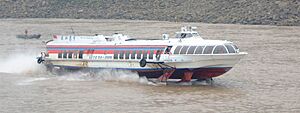
Chongqing is one of the most important inland ports in China. There are numerous luxury cruise ships that terminate at Chongqing, cruising downstream along the Yangtze River to Yichang, Wuhan, Nanjing or even Shanghai. In the recent past, this provided virtually the only transportation option along the river. However, improved rail, expressways and air travel have seen this ferry traffic reduced or cancelled altogether. Most of the river ferry traffic consists of leisure cruises for tourists rather than local needs. Improved access by larger cargo vessels has been made due to the construction of the Three Gorges Dam. This allows bulk transport of goods along the Yangtze River. Coal, raw minerals and containerized goods provide the majority of traffic plying this section of the river. Several port handling facilities exist throughout the city, including many impromptu river bank sites.
Highways
Traditionally, the road network in Chongqing has been narrow, winding and limited to smaller vehicles because of the natural terrain, large rivers and the huge population demands on the area, especially in the Yuzhong District. In other places, such as Jiangbei, large areas of homes and buildings have recently been cleared to improve the road network and create better urban planning; thus, several ring roads have also been constructed. This has seen many tunnels and large bridges needing to be built across the city. The construction of many expressways have connected Chongqing to its neighbors. The natural mountainous terrain that Chongqing is built on makes many road projects difficult to construct, including for example some of the world's highest road bridges.
Unlike many other Chinese cities, it is rare for motorbikes, electric scooters or bicycles to be seen on Chongqing's Roads. This is due to the extremely hilly and mountainous nature of Chongqing's roads and streets. However, despite this, Chongqing is a manufacturing center for these types of vehicles.
- Chongqing-Chengdu Expressway
- Chongqing-Chengdu 2nd Expressway (under construction)
- Chongqing-Wanzhou-Yichang Highway (Wanzhou-Yichang section under construction)
- Chongqing-Guiyang Highway
- Chongqing-Changsha Expressway (Xiushan-Changsha section under construction)
- Chongqing-Dazhou-Xi'a Highway (Dazhou-Xi'an section under construction)
- Chongqing-Suining Expressway
- Chongqing-Nanchong Expressway
- China National Highway 210
- China National Highway 212
Bridges
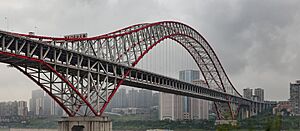
With so many bridges crossing the Yangtze and Jialing rivers in the urban area, Chongqing is sometimes known as the 'Bridge Capital of China'. The first important bridge in urban Chongqing was the Niujiaotuo Jialing River Bridge, built in 1958. The first bridge over the Yangtze river was the Shibanpo Yangtze River Bridge (or Chongqing Yangtze River Bridge) built in 1977.
As of 2014[update], within the area of the 9 districts, there were 20 bridges on the Yangtze river and 28 bridges on the Jialing river. The bridges in Chongqing exhibit a variety of shapes and structures, making Chongqing a showcase for bridge design.
Airports
The major airport of Chongqing is Chongqing Jiangbei International Airport (IATA: CKG, ICAO: ZUCK). It is located in Yubei District. The airport offers a growing network of direct flights to China, Southeast Asia, the Middle East, North America, and Europe. It is located 21 km (13 mi) north of Downtown Chongqing and serves as an important aviation hub for southwest China. Jiangbei airport is a hub for China Southern Airlines, Chongqing Airlines, Sichuan Airlines, China Express Airlines, Shandong Airlines and Hainan Airlines's new China West Air. Chongqing also is a focus city of Air China, therefore it is very well connected with Star Alliance and SkyTeam's international network. The airport currently has three parallel runways in operation. It serves domestic routes to most other Chinese cities, as well as international routes to Auckland, New York City, London, Los Angeles, Moscow, Doha, Dubai, Seoul, Bangkok, Phuket, Osaka, Singapore, Chiang Mai, Phnom Penh, Siem Reap, Malé, Bali, Tokyo, Kuala Lumpur, Batam, Rome and Helsinki. As of 2021[update], Jiangbei Airport was the 4th busiest airport in terms of passenger traffic in mainland China.
Currently, Jiangbei airport has three terminals. Chongqing Airport has metro access (CRT Line 3 and Line 10) to its central city, and two runways in normal use.
There are four other airports in Chongqing Municipality: Qianjiang Wulingshan Airport, Wanzhou Wuqiao Airport, Chongqing Xiannüshan Airport, and Chongqing Wushan Airport. They are all class 4C airports and serve passenger flights to domestic destinations including Beijing, Shanghai and Kunming.
Culture
Language
The language native to Chongqing is Southwestern Mandarin. More precisely, the great majority of the municipality, save for Xiushan, speak Sichuanese, including the primary Chengdu-Chongqing dialect and Minjiang dialect spoken in Jiangjin and Qijiang. There are also a few speakers of Xiang and Hakka in the municipality, due to the great immigration wave to the Sichuan region (湖廣填川) during the Ming and Qing dynasties. In addition, in parts of southeastern Chongqing, the Miao and Tujia languages are also used by some Miao and Tujia people.
Tourism
As the provisional Capital of China for almost ten years (1937 to 1945), the city was also known as one of the three headquarters of the Allies during World War II, as well as being a strategic center of many other wars throughout China's history. Chongqing has many historic war-time buildings or sites, some of which have since been destroyed. These sites include the People's Liberation Monument, located in the center of Chongqing city. It used to be the highest building in the area, but is now surrounded and dwarfed by numerous shopping centers. Originally named the Monument for the Victory over Axis Armies, it is the only building in China for that purpose. Today, the monument serves as a symbol for the city. The General Joseph W. Stilwell Museum, dedicated to General "Vinegar Joe" Stilwell, a World War II general. the air force cemetery in the Nanshan area, in memory of those air force personnel killed during the Second Sino-Japanese War (1937–1945), and the Red Rock Village Museum, a diplomatic site for the Communist Party in Chongqing led by Zhou Enlai during World War II, and Guiyuan, Cassia Garden, where Mao Zedong signed the "Double 10 (10 October) Peace Agreement" with the Kuomintang in 1945.
- The Baiheliang Underwater Museum, China's first underwater museum,
- The Memorial of Great Tunnel Massacre, a former air-raid shelter where a major massacre occurred during World War II.
- The Great Hall of the People in Chongqing is based on the Great Hall of the People in Beijing. This is one of the largest public assembly buildings in China which, though built in modern times, emulates traditional architectural styles. It is adjacent to the densely populated and hilly central district, with narrow streets and pedestrian only walkways,
- The large domed Three Gorges Museum presents the history, culture, and environment of the Three Gorges area and Chongqing.
- Chongqing Art Museum is known for striking architecture.
- Chongqing Science and Technology Museum has an IMAX theater.
- Luohan Si, a Ming dynasty temple,
- Huangguan Escalator, the second longest escalator in Asia.
- Former sites for embassies of major countries during the 1940s. As the capital at that time, Chongqing had many residential and other buildings for these officials.
- Wuxi County, noted as a major tourism area of Chongqing,
- The Dazu Rock Carvings, in Dazu county, are a series of Chinese religious sculptures and carvings, dating back as far as the 7th century A.D., depicting and influenced by Buddhist, Confucian and Taoist beliefs. Listed as a UNESCO World Heritage Site, the Dazu Rock Carvings are made up of 75 protected sites containing some 50,000 statues, with over 100,000 Chinese characters forming inscriptions and epigraphs.,
- The Three Natural Bridges and Furong Cave in Wulong Karst National Geology Park, Wulong County are listed as a UNESCO World Heritage Site as part of the South China Karst,
- Ciqikou is a 1000-year-old town in the Shapingba District of Chongqing. It is also known as "Little Chongqing". The town, located next to the lower reaches of the Jialing River, was at one time an important source of china-ware and used to be a busy commercial dock during the Ming and Qing dynasties,
- Fishing Town or Fishing City is one of the three great ancient battlefields of China. It is noted for its resistance to the Mongol armies during the Southern Song dynasty (1127–1279) and the location where the Mongol leader Möngke Khan died in 1259,
- Xueyu Cave in Fengdu County is the only example of a pure white, jade-like karst cave in China,
- Fengdu Ghost City in Fengdu County is the Gate of the Hell in traditional Chinese literature and culture.
- Snowy Jade Cave, see Xueyu Cave (above).
- Baidi Cheng, a peninsula in Yangtze River, known due to a famous poem by Li Bai.
- The Chongqing Zoo, a zoo that exhibits many rare species including the giant panda, the extremely rare South China tiger, and the African elephant.
- Chongqing Amusement Park.
- Chongqing Grand Theater, a performing arts center.
- Foreigners' Street was an amusement park, including the Porcelain Palace, the world's largest toilet. Also the location of the abortive Love Land development in 2009.
- The Black Mountain Valley (Heishangu).
- Hongya Cave (aka Hongya Dong), a pier stilt house fortress that served as one of the 17 city gates of Ancient Chongqing is a popular tourist attraction for its architecture.
Cuisine
Chongqing food is part of Sichuan cuisine. Chongqing is known for its spicy food. Its food is normally considered numbing because of the use of Sichuan pepper, also known as Sichuan peppercorn, containing hydroxy alpha sanshool. Chongqing's city center has many restaurants and food stalls where meals often cost less than RMB10. Local specialties here include dumplings and pickled vegetables and, different from many other Chinese cuisines, Chongqing dishes are suitable for the solo diner as they are often served in small individual sized portions. Among the delicacies and local specialties are these dishes:
- Chongqing hot pot– Chongqing's local culinary specialty which was originally from Northern China. Tables in hot pot restaurants usually have a central pot, where food ordered by the customers is boiled in a spicy broth, items such as beef, pork, tripe, kidney slices, pork aorta and goose intestine are often consumed.
- Chongqing Xiao Mian – a common lamian noodle dish tossed with chili oil and rich mixtures of spices and ingredients
- Jiangtuan fish – since Chongqing is located along Jialing River, visitors have a good opportunity to sample varieties of aquatic products. Among them, is a fish local to the region, Jiangtuan fish: Hypophthalmichthys nobilis although more commonly known as bighead carp. The fish is often served steamed or baked. Wanzhou district is famous for baking Jiangtuan fish.
- Suan La Fen (Sour and Spicy Sweet-Potato Noodles) – Thick, transparent noodles of rubbery texture in a spicy vinegar soup.
- Lazi Ji (Spicy Chicken) – A stir-fried dish consists of marinated then deep-fried pieces of chicken, dried Sichuan chili peppers, Sichuan peppercorns, garlic, and ginger, originated near Geleshan in Chongqing.
- Quanshui Ji (Spring Water Chicken) – Quanshui Ji is cooked with the natural spring water in the Southern Mountain of Chongqing.
- Pork leg cooked with rock sugar – A common household dish of Chongqing, the tender, reddish finished dish, has been described as having strong and sweet aftertaste.
- Qianzhang (skimmed soy bean cream) – Qianzhang is the cream skimmed from soybean milk. In order to create this, several steps must be followed very carefully. First, soybeans are soaked in water, ground, strained, boiled, restrained several times and spread over gauze until delicate, snow-white cream is formed. The paste can also be hardened, cut into slivers and seasoned with sesame oil, garlic and chili oil. Another variation is to bake the cream and fry it with bacon, which is described as soft and sweet.
- Fish with pickled mustard greens – a dish originating from Chongqing
Media
The Chongqing People's Broadcast Station is Chongqing's largest radio station. The only municipal-level TV network is Chongqing TV, claimed to be the 4th largest television station in China. Chongqing TV broadcasts many local-oriented channels, and can be viewed on many TV sets throughout China.
Sports and recreation
Basketball
Chongqing Soaring Dragons became the 20th team playing in Chinese Basketball Association in 2013. They play at Datianwan Arena, in the same sporting complex as Datianwan Stadium. The team moved to Beijing in 2015 and is currently known as Beijing Royal Fighters.
Soccer
Professional soccer teams in Chongqing include:
- Chongqing Liangjiang Athletic, folded
- Chongqing F.C., folded
Chongqing Liangjiang Athletic was a professional Chinese soccer club that played in the Chinese Super League. They were owned by the Chongqing-based Lifan Group, which manufactures motorcycles, cars and spare parts. Originally called Qianwei (Vanguard) Wuhan, the club formed in 1995 to take part in the recently developed, fully professional Chinese Soccer League. They would quickly rise to top tier of the system and experience their greatest achievement in winning the 2000 Chinese FA Cup, and coming in fourth within the league. However, since then they have struggled to replicate the same success, and have twice been relegated from the top tier.
Chongqing FC was a soccer club located in the city that competed in China League One, the country's second-tier soccer division, before being relegated to the China League Two, and dissolved due to a resultant lack of funds.
Sport venues
Sport venues in Chongqing include:
- The Chongqing Olympic Sports Center is a multipurpose stadium. It is currently used mostly for soccer matches, as it has a grass surface, and can hold 58,680. It was built in 2002 and was one of main venues for the 2004 AFC Asian Cup.
- Yanghe Stadium is a multiuse stadium that is currently used mostly for soccer matches. The stadium holds 32,000 people, and is the home of Chongqing Lifan in the Chinese Super League. The stadium was purchased by the Lifan Group in 2001 for RMB80 million and immediately replaced Datianwan Stadium as the home of Chongqing Lifan.
- Datianwan Stadium is a multipurpose stadium that is currently used mostly for soccer matches. The stadium has a capacity 32,000 people, and up until 2001 was the home of Chongqing Lifan.
Cloud Valley
At the end of 2020, a collaboration between a Danish architecture firm and a Chinese tech company Terminus was announced, taking the form of an AI-controlled campus. The project is named Cloud Valley and aims to use sensors and WiFi-controlled devices to collect data on the city's residents and atmosphere, including weather and eating and sleeping habits. The AI will adapt devices to work in a way that fits the gathered information and improves residents' lives.
Notable people
- Ba Manzi: a legendary hero of Ba kingdom in Zhou dynasty
- Ba Qing, the Widow: the earliest known female merchant in Chinese history who provided huge financial aid to Qin Shi Huang to construct the Great Wall
- Gan Ning: a general serving under warlord Sun Quan in the last years of Han dynasty
- Yan Yan: a loyal general during Three Kingdoms period
- Lanxi Daolong: a famous Buddhism monk and philosopher in Song dynasty who went to Japan and established the Kenchō-ji
- Qin Liangyu: a popular heroine in Ming dynasty who fought against Manchus
- Nie Rongzhen: marshal of the People's Liberation Army of China
- Liu Bocheng: an early leader of Chinese communist party during Anti-Japanese War
- Lu Zuofu: a notable industrialist and businessman who was a member of Chinese United League and a leader of Railway Protection Movement, established the Beibei District, Chongqing Natural History Museum, Jianshan High School, the Northern Hot Spring Park of Chongqing and Beibei Library, and served as the chief official of Food Bureau during the Republic of China period.
- Liu Yongqing: wife of the former president and Party general secretary Hu Jintao
- Zhonghua Pang: renowned calligrapher and geologist
- Xia Peisu: computer scientist
- Huang Qian: chess player
- Tian Liang: Olympic diving gold medalist
- Li Yundi: pianist
- Karry Wang: member of the pop band TFBoys and actor
- Roy Wang: singer-songwriter and member of TFBoys, also an actor and TV host
- Li Hua: artist who studied in Europe
- Xiao Zhan: actor, singer, and member of the boy group X Nine
- Pan Wenhua: born in Renshou County, Sichuan Province, was a famous military general regarded as a born military prodigy
- Zhou Zhennan: leader of C-pop group R1SE
- Shi Tingmao: Olympic diving gold medalist
- Chen Zihan : actress
- Shuguang Zhang : biochemist
- Xia Li: professional wrestler signed with WWE
- Feng Timo : singer, pop star and internet personality
- Domee Shi: Chinese Canadian animator, director and screenwriter
International relations
Consulates
| Consulate | Date | Consular District |
| Canada Consulate-General, Chongqing | 05.1998 | Chongqing, Sichuan, Guizhou, Yunnan |
| United Kingdom Consulate-General, Chongqing | 03.2000 | Chongqing, Sichuan, Guizhou, Yunnan |
| Cambodia Consulate-General, Chongqing | 12.2004 | Chongqing, Hubei, Hunan, Shaanxi |
| Japan Consulate-General, Chongqing | 01.2005 | Chongqing, Sichuan, Guizhou, Yunnan, Shaanxi |
| Philippines Consulate-General, Chongqing | 12.2008 | Chongqing, Guizhou, Yunnan |
| Hungary Consulate-General, Chongqing | 02.2010 | Chongqing, Sichuan, Guizhou, Yunnan, Shaanxi, Gansu |
| Ethiopia Consulate-General, Chongqing | 11.2011 | Chongqing, Sichuan, Guizhou, Yunnan |
| Italy Consulate-General, Chongqing | 12.2013 | Chongqing, Sichuan, Guizhou, Yunnan |
| Uruguay Consulate-General, Chongqing | 12.2019 | Chongqing, Sichuan, Yunnan, Shaanxi, Gansu |
Twin towns – sister cities
Chongqing has sister city relationships with many cities of the world including:
 Toulouse, France (1982)
Toulouse, France (1982) Seattle, United States (1983)
Seattle, United States (1983) Detroit, United States (1986)
Detroit, United States (1986) Toronto, Canada (1986)
Toronto, Canada (1986) Hiroshima, Japan (1986)
Hiroshima, Japan (1986) Leicester, United Kingdom (1993)
Leicester, United Kingdom (1993) Voronezh, Russia (1993)
Voronezh, Russia (1993) Zaporizhzhia, Ukraine (2002)
Zaporizhzhia, Ukraine (2002) Mpumalanga, South Africa (2002)
Mpumalanga, South Africa (2002) Sliven, Bulgaria (2002)
Sliven, Bulgaria (2002) Düsseldorf, Germany (2004)
Düsseldorf, Germany (2004) Brisbane, Australia (2005)
Brisbane, Australia (2005) Shiraz, Iran (2005)
Shiraz, Iran (2005) Aswan, Egypt (2005)
Aswan, Egypt (2005) Busan, South Korea (2007)
Busan, South Korea (2007) Sør-Trøndelag, Norway (2007)
Sør-Trøndelag, Norway (2007) Chiang Mai Province, Thailand (2008)
Chiang Mai Province, Thailand (2008) Córdoba, Argentina (2010)
Córdoba, Argentina (2010) Budapest, Hungary (2010)
Budapest, Hungary (2010) Bangkok, Thailand (2005)
Bangkok, Thailand (2005) Antwerp, Belgium (2011)
Antwerp, Belgium (2011) Salvador, Bahia, Brazil (2011)
Salvador, Bahia, Brazil (2011) Chennai, India (2015)
Chennai, India (2015) Maribor, Slovenia (2017)
Maribor, Slovenia (2017) Telde, Spain (2018)
Telde, Spain (2018)
See also
 In Spanish: Chongqing para niños
In Spanish: Chongqing para niños



